Related Research Articles

The saxophone is a type of single-reed woodwind instrument with a conical body, usually made of brass. As with all single-reed instruments, sound is produced when a reed on a mouthpiece vibrates to produce a sound wave inside the instrument's body. The pitch is controlled by opening and closing holes in the body to change the effective length of the tube. The holes are closed by leather pads attached to keys operated by the player. Saxophones are made in various sizes and are almost always treated as transposing instruments. A person who plays the saxophone is called a saxophonist or saxist.
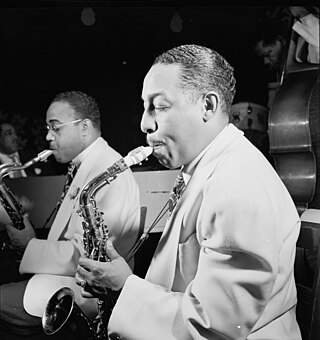
John Cornelius "Johnny" Hodges was an American alto saxophonist, best known for solo work with Duke Ellington's big band. He played lead alto in the saxophone section for many years. Hodges was also featured on soprano saxophone, but refused to play soprano after 1946. Along with Benny Carter, Hodges is considered to be one of the definitive alto saxophone players of the big band era.

The South African music scene includes both popular (jive) and folk forms like Zulu isicathamiya singing and harmonic mbaqanga. Other popular genres are marabi, kwaito,house music, pop music, isicathamiya, gqom, rock music, hip hop and amapiano.
Mbaqanga is a style of South African music with rural Zulu roots that continues to influence musicians worldwide today. The style originated in the early 1960s, and blends traditional African vocal styles and melodies with European and American popular music.
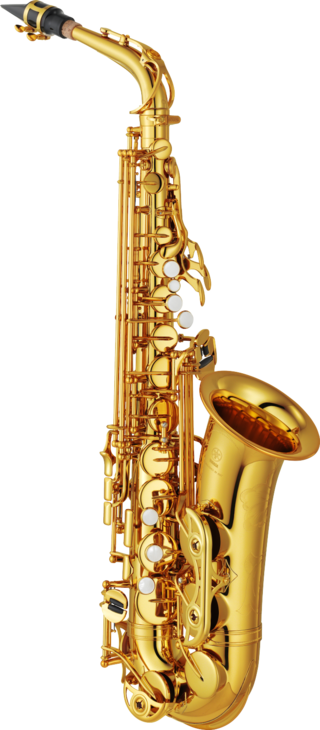
The alto saxophone is a member of the saxophone family of woodwind instruments. Saxophones were invented by Belgian instrument designer Adolphe Sax in the 1840s and patented in 1846. The alto saxophone is pitched in the key of E♭, smaller than the B♭ tenor but larger than the B♭ soprano. It is the most common saxophone and is used in popular music, concert bands, chamber music, solo repertoire, military bands, marching bands, pep bands, carnatic music, and jazz.

The tenor saxophone is a medium-sized member of the saxophone family, a group of instruments invented by Adolphe Sax in the 1840s. The tenor and the alto are the two most commonly used saxophones. The tenor is pitched in the key of B♭ (while the alto is pitched in the key of E♭), and written as a transposing instrument in the treble clef, sounding an octave and a major second lower than the written pitch. Modern tenor saxophones which have a high F♯ key have a range from A♭2 to E5 (concert) and are therefore pitched one octave below the soprano saxophone. People who play the tenor saxophone are known as "tenor saxophonists", "tenor sax players", or "saxophonists".
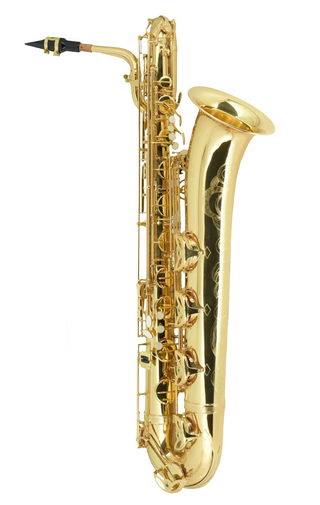
The baritone saxophone is a member of the saxophone family of instruments, larger than the tenor saxophone, but smaller than the bass. It is the lowest-pitched saxophone in common use — the bass, contrabass and subcontrabass saxophones are relatively uncommon. Like all saxophones, it is a single-reed instrument. It is commonly used in concert bands, chamber music, military bands, big bands, and jazz combos. It can also be found in other ensembles such as rock bands and marching bands. Modern baritone saxophones are pitched in E♭.

Richard Malden "Dick" Heckstall-Smith was an English jazz and blues saxophonist. He played with some of the most influential English blues rock and jazz fusion bands of the 1960s and 1970s. He is known for primarily playing tenor, soprano, and baritone saxophones, as well as piano, clarinet and alto saxophone.

The bass saxophone is one of the lowest-pitched members of the saxophone family—larger and lower than the more common baritone saxophone. It was likely the first type of saxophone built by Adolphe Sax, as first observed by Berlioz in 1842. It is a transposing instrument pitched in B♭, an octave below the tenor saxophone and a perfect fourth below the baritone saxophone. A bass saxophone in C, intended for orchestral use, was included in Adolphe Sax's patent, but few known examples were built. The bass saxophone is not a commonly used instrument, but it is heard on some 1920s jazz recordings, in free jazz, in saxophone choirs and sextets, and occasionally in concert bands and rock music.
Mango Groove is an 11-piece South African Afropop band whose music fuses pop and township music—especially marabi and kwela.
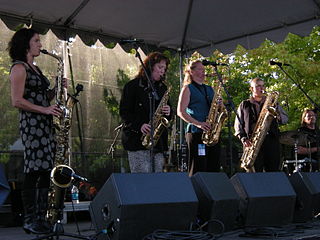
The Tiptons Sax Quartet, previously known as The Billy Tipton Memorial Saxophone Quartet, is a jazz saxophone quartet from Seattle, Washington. The ensemble consists of five members. The Tiptons are an internationally renowned saxophone quartet with drums, celebrating over 30 years as a band. Amy Denio is joined by co-leader Jessica Lurie, Sue Orfield, Tina Richerson and Robert Kainar from Salzburg, Austria. The Tiptons' material ranges from micro-Big Band to Gospel, Bluegrass to Balkan, whimsical Chamber Jazz, and nocturnal Funk to Free Jazz Improvisation using saxophones, clarinet, their voices, drums, and inventive percussion to create a genre-busting ‘world soul’ sound. The band takes its name in honor of Billy Tipton, a 20th-century professional saxophonist and transgender man who upon his death was revealed to have been assigned female at birth.
The Blue Notes were a South African jazz sextet, whose definitive line-up featured Chris McGregor on piano, Mongezi Feza on trumpet, Dudu Pukwana on alto saxophone, Nikele Moyake on tenor saxophone, Johnny Dyani on bass, and Louis Moholo-Moholo on drums. After moving away from their home country in 1964, they established themselves on the European jazz circuit, where they continued to play and record through the 1970s. They are now considered one of the great free jazz bands of their era, whose music was given a unique flavour by their integration of African styles such as Kwela into the progressive jazz ideas of the time.
South African jazz is the jazz of South Africa.

David Van Kriedt was a composer, saxophonist and music teacher.
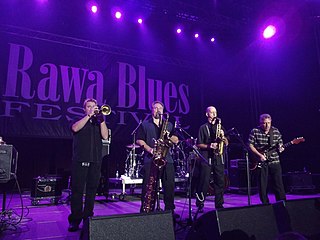
Roomful of Blues is an American jump blues and swing revival big band based in Rhode Island. With a recording career that spans over 50 years, they have toured worldwide and recorded many albums. Roomful of Blues, according to the Chicago Sun-Times, "Swagger, sway and swing with energy and precision". Since 1967, the group’s blend of swing, rock and roll, jump blues, boogie-woogie and soul has earned it five Grammy Award nominations and many other accolades, including seven Blues Music Awards. Billboard called the band "a tour de force of horn-fried blues…Roomful is so tight and so right." The Down Beat International Critics Poll has twice selected Roomful of Blues as Best Blues Band.
Lloyd Hunter was an American trumpeter and big band leader from North Omaha, Nebraska.
Winston Monwabisi "Mankunku" Ngozi was a famous South African tenor saxophone player.
Timothy M. Ries is an American saxophonist, composer, arranger, band leader, and music educator at the collegiate/conservatory level. Ries is in his seventeenth year as a professor of jazz studies at the University of Toronto. His universe of work as composer, arranger, and instrumentalist ranges from rock to jazz to classical to experimental to ethno to fusions of respective genres thereof. His notable works with wide popularity include The Rolling Stones Project, a culmination of jazz arrangements of music by the Rolling Stones produced on two albums, the first in 2005 and the second in 2008.

Dorkay House is situated on Portion 168 of Farm Turnfontein at 5–7 Eloff Street, Johannesburg, South Africa. It was constructed in 1952 and was designed by architect Colman Segal (1923–1988). It takes its name from the original owner, Dora Kotzen.
Makwenkwe "Mackay" Davashe (1920–1972) was a South African musician. He achieved success as a saxophonist and composer with the Manhattan Brothers and later the Jazz Epistles.
References
- 1 2 3 "African Jazz Pioneers". Jamally.co.za. 18 December 2000. Archived from the original on 30 November 2011. Retrieved 17 February 2012.
- ↑ "Impresario – African Jazz Pioneers". Home.mweb.co.za. 18 December 2000.
- ↑ Machosky, Shaunna Morrison (15 June 2010). "Kick It Up With South African Jazz". NPR. Archived from the original on 16 August 2022. Retrieved 18 April 2024.
- ↑ Majopelo, Max. Beyond Memory: Recording the History, Moments and Memories of South African Music. African Minds. p. 253. ISBN 1920299289.
- ↑ Majopelo, Max. Beyond Memory: Recording the History, Moments and Memories of South African Music. African Minds. p. 253. ISBN 1920299289.
- ↑ "South African Music". Music.org.za. 18 December 2000.
- ↑ "African Jazz Pioneers: Afrika Vukani". Allaboutjazz.com.